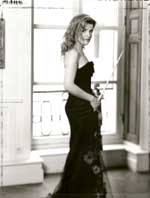
At the age of 36, Anne-Sophie Mutter already seems to have had three careers. First there was the earnest violin prodigy of 13 who found a powerful mentor in the great conductor Herbert von Karajan. Next came the glamorous young thing who often captured more attention for her strapless concert gowns than for her playing (the instrument, we were told, needed direct contact with bare skin in order for the tone to throb with maximum vibrancy). Just when many were beginning to dismiss her as another bimbo violinist à la Vanessa-Mae, Mutter suddenly got very serious, addressing contemporary music and commissioning important composers to write pieces for her. She now plays that repertory with ferocious commitment, and even fills halls with it; her recent recitals in Carnegie Hall and appearances with the New York Philharmonic, spread over twelve days, attracted large audiences.
And those audiences were treated generously to a lot of tough music. On two solo recitals and three programs with orchestra (each played twice), Mutter performed a total of sixteen scores, offering a veritable crash course in twentieth-century violin music. Such retrospectives have been cropping up everywhere as the new millennium dawns, but that hardly detracts from Mutter’s enterprise, her stamina, and her technical excellence. Her programming was equally crafty, balancing such familiar nonthreatening classics as the Sibelius Concerto and Ravel’s Tzigane with the newer, more challenging sounds of George Crumb’s Four Nocturnes (Night Music II) and Wolfgang Rihm’s Time Chant. There were also major works that hover on the periphery of the repertory, all deserving of more exposure: Lutoslawski’s Chain II, Bernstein’s Serenade, the Berg Concerto, Bartók’s Sonata No. 2, Respighi’s Sonata from 1916-17.
Now flourishing in career No. 3, Mutter has it all: audience acclaim, critical respect, a technique second to none, a sense of musical adventure, the luxury to play what she wants, a faithful record company (Deutsche Grammophon), and classic ice-princess beauty. In some ways her most amazing achievement has been winning over concertgoers in New York City, where the long-preferred standard has been the more highly charged, lushly phrased playing of such violinists as Isaac Stern or Itzhak Perlman. Mutter’s style is far removed from theirs in its emotional restraint yet exceptionally wide tonal range and willingness to risk unconventional expressive gestures – the Sibelius Concerto was full of them, extreme tempo contrasts and coloristic touches that surely startled many ears. Well, good for her; such independent spirits who can grow up so impressively and bring audiences along with them are always rare.